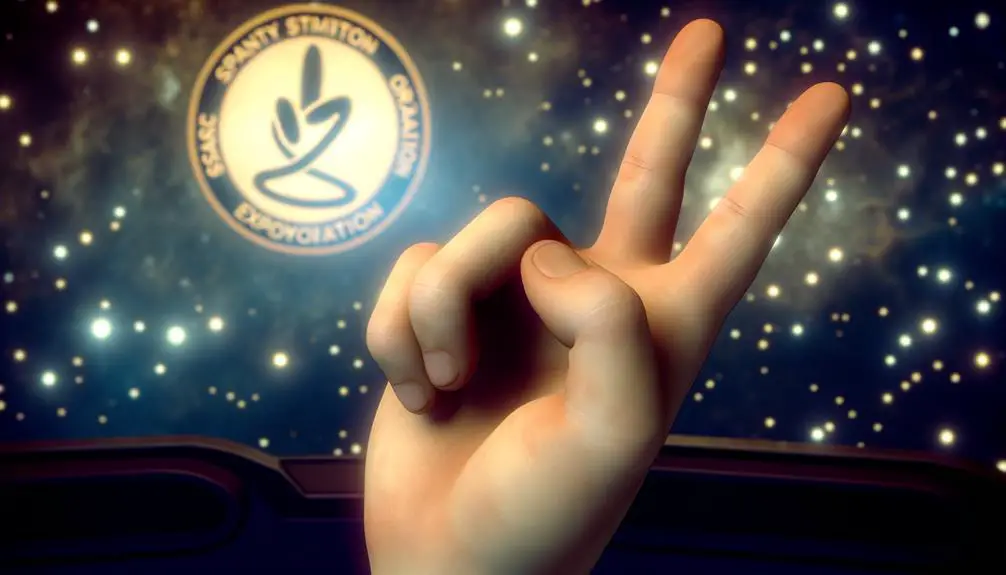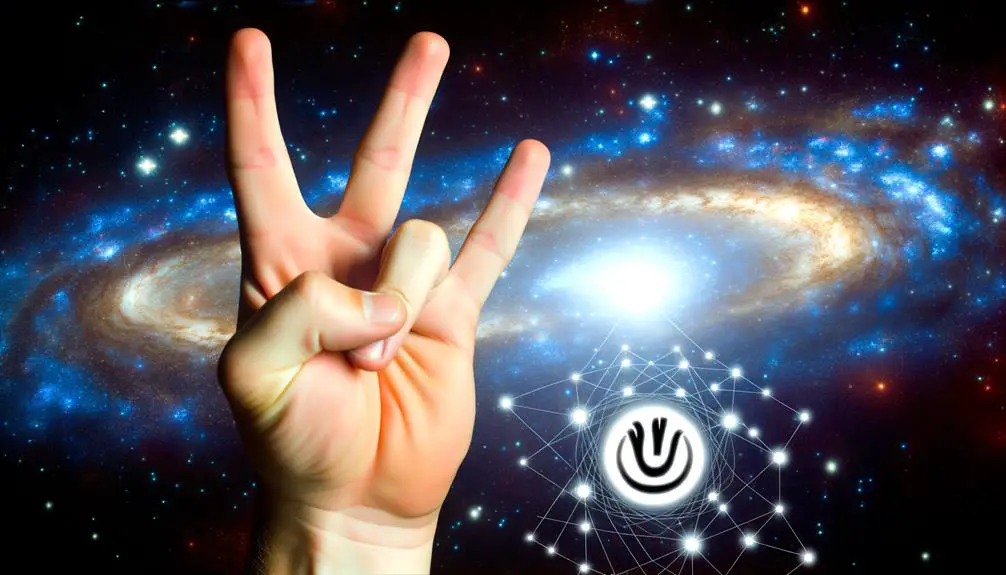What Is the Star Trek Hand Symbol Meaning?
The Star Trek hand symbol, known as the Vulcan salute, originates from the Jewish Priestly Blessing. This gesture, adopted by Leonard Nimoy, who played Spock, symbolizes the Hebrew letter 'Shin' and represents one of God's names, 'Shaddai'.
Embedded with themes of divine blessings and protection, it enhances Spock's character with authenticity and cultural depth. In the Star Trek universe, it underscores coexistence, respect, and the Vulcan philosophy of logic.
Globally, it has become a symbol of peace and inclusivity, resonating beyond its fictional origins. Exploring its extensive cultural impact and modern variations reveals a rich tapestry of meaning.

Key Takeaways
- The Star Trek hand symbol is inspired by the Jewish Priestly Blessing gesture.
- It symbolizes the Hebrew letter 'Shin' and the word 'Shaddai,' one of God's names.
- Leonard Nimoy adapted the gesture for Spock's Vulcan salute, adding depth to the character.
- The salute represents Vulcan philosophy of logic, emotional control, and cultural coexistence.
- It has become a globally recognized symbol of peace, inclusivity, and mutual respect.
Origins in Jewish Tradition
The iconic hand gesture popularized by Star Trek's Vulcan salute finds its origins in Jewish tradition, specifically the ancient Priestly Blessing performed by Kohanim. During this blessing, Kohanim (Jewish priests) extend their fingers in a specific configuration, forming a shape resembling the Hebrew letter 'Shin,' symbolizing the word 'Shaddai,' one of the names for God.
This ritual, rich in historical and religious significance, is performed during significant Jewish holidays and occasions. The gesture represents the transmission of divine blessings and protection to the congregation. Understanding this context adds layers of meaning to the gesture, illustrating how cultural and religious symbols can transcend their origins to become part of broader popular culture, embodying universal themes of peace and goodwill.
Leonard Nimoy's Inspiration
Drawing upon his childhood experiences in an Orthodox Jewish community, Leonard Nimoy found inspiration for Spock's iconic Vulcan salute in the sacred gestures of the Priestly Blessing. This blessing, performed by Kohanim in synagogues, involves a hand configuration that Nimoy witnessed as a child during religious ceremonies.
Intrigued by the profound spiritual and cultural significance of this gesture, Nimoy adapted it into the Vulcan salute, imbuing Spock's character with a sense of deep tradition and otherworldliness. Nimoy's creative genius lay in his ability to translate this ancient symbol into a futuristic context, thereby bridging his heritage with his role on 'Star Trek.'
This decision added a layer of authenticity and depth to Spock, resonating with audiences worldwide.
Symbolism in Star Trek

Leonard Nimoy's adaptation of the Priestly Blessing into the Vulcan salute exemplifies how 'Star Trek' intricately weaves symbolic elements into its narrative, creating a rich tapestry of meaning that extends beyond mere science fiction. These symbols not only enhance the storytelling but also resonate deeply with the audience.
The Vulcan salute represents the coexistence and mutual respect between different cultures and species in the Star Trek universe.
It embodies the human drive for exploration, peace, and understanding, pivotal themes within the series.
The salute has become an emblem of Vulcan philosophy, illustrating the importance of logic and emotional control.
Through these symbols, 'Star Trek' offers profound commentary on societal values and human potential.
Cultural Impact and Adoption
How has the Vulcan salute transcended its origins in 'Star Trek' to become a globally recognized symbol of peace and cultural inclusivity? The answer lies in its adoption across diverse contexts, from pop culture to diplomatic gestures. Rooted in Jewish tradition, the salute's simplicity and profound message of "Live long and prosper" resonate universally. Its cultural impact is evident in various sectors:
| Context | Example |
|---|---|
| Pop Culture | Referenced in films, TV shows, and memes |
| Social Movements | Used as a symbol of unity and solidarity |
| International Diplomacy | Employed in greetings by world leaders |
This widespread adoption underscores the Vulcan salute's transformation into a symbol that transcends its fictional origins, embodying values of peace and inclusivity.
Variations and Modern Usage

The Vulcan salute, originally a symbol of peace and prosperity in 'Star Trek,' has evolved into various forms and usages in modern society, reflecting its adaptability and enduring relevance. Its modern applications range from casual greetings to significant cultural expressions, showcasing its versatility beyond its sci-fi origins.
For instance:
- Digital Communication: The emoji version (�) is widely used in text messaging and social media, symbolizing camaraderie.
- Cultural Events: It appears at conventions and fan gatherings as a sign of shared identity and mutual respect.
- Commercial Branding: Some companies leverage the salute in marketing campaigns to evoke a sense of innovation and futuristic vision.
This evolution underscores the salute's profound impact, transcending its fictional roots to become a universal symbol.
Conclusion
The 'Star Trek' hand symbol, rooted in Jewish tradition and popularized by Leonard Nimoy, has transcended its origin to become a significant cultural icon.
Its symbolism within the 'Star Trek' universe as a gesture of peace and prosperity has resonated widely, leading to diverse modern adaptations.
This evolution underscores the hand symbol's enduring relevance and the profound impact of cultural elements on broader societal contexts, thereby enriching the narrative of cultural convergence and continuity.





